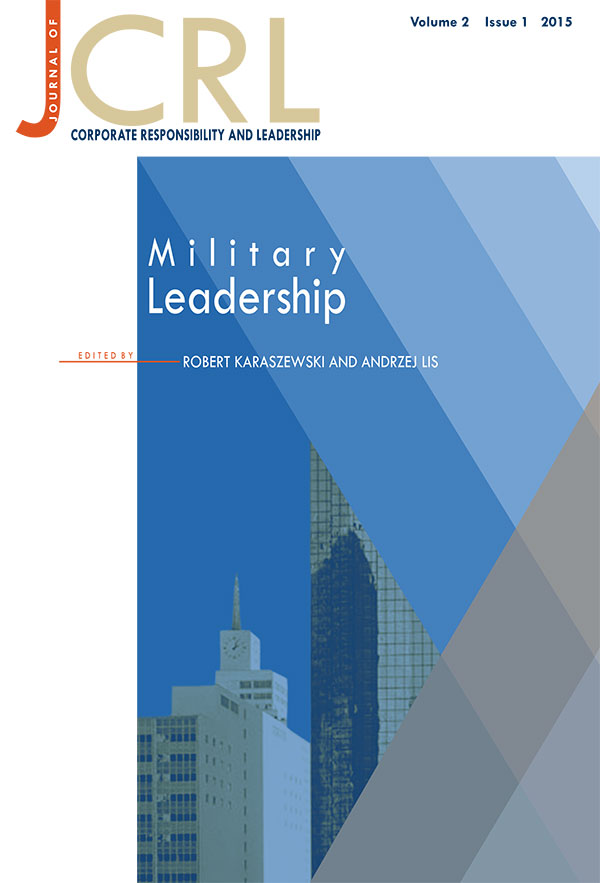Transformational Leadership in the Estonian Defence Forces
DOI:
https://doi.org/10.12775/JCRL.2015.002Keywords
transformational leadership, confirmatory factor analysis, scale adaptation, military, EstoniaAbstract
Purpose – The study is a contribution to the validation of the 15 items and 5 subscales Transformational Leadership Scale (TLS) proposed by Rafferty and Griffin (2004).
Design/methodology/approach – The sample includes participants from different levels of the Estonian Defence Forces (EDF) military hierarchy (N=2570). The structure of the TLS was examined by using exploratory and confirmatory factor analyses. Additionally ANOVA was used to compare the results between different subsamples.
Findings – TLS showed satisfactory reliability. Confirmatory factor analyses found TLS as valid five dimensions instrument to measure transformational leadership in the Estonian military context. Different management levels showed different emphases among the dimensions of transformational leadership.
Research and practical limitations/implications – TLS will be an important tool to use in transformational leadership research in the Estonian military context and beyond. Additionally, the current research contributes to the development of alternative measurement tools besides the most commonly used MLQ. The limitation of the work will be the rather homogenous sample from the Estonian military, however it will open the door for the subsequent research using different samplings.
Originality/value – The current research found TLS to be a reliable and valid instrument, very short and therefore easy to administrate, having the possibility to use it with five dimensional and as one general transformational instrument as well.
References
Alimo-Metcalfe, B., Alban-Metcalfe, R.J. (2001), “The Development of a New Transformational Leadership Questionnaire”, Journal of Occupation and Organizational Psychology, Vol. 74, pp. 1 – 27.
Antonakis, J. (2012), “Transformational and Charismatic Leadership”, in: Day, D.V.,
Antonakis, J. (Eds.), The Nature of Leadership, SAGE Publication Inc., Los Angeles, CA, pp. 256 – 288.
Bass, B.M. (1985), Leadership and Performance Beyond Expectations, Free Press, New York.
Bass, B.M. (1998), Transformational Leadership: Industrial, Military, and Educational Impact, Lawrence Erlbaum Associates, Mahwah, NJ.
Bass, B.M., Avolio, B.J. (1997), Full Range Leadership Development: Manual for the Multifactor Leadership Questionnaire, Mind Garden, Redwood City, CA.
Bass, B.M., Riggio, R.E. (2006), Transformational Leadership (2nd ed.), Lawrence Erlbaum, Mahwah, NJ.
Bennis, W.G., Nanus, B. (1985), Leaders: The Strategies for Taking Charge, Harper & Row, New York.
Burns, J.M. (1978), Leadership, Harper & Row, New York.
Carless, S.A. (1998), “Assessing the Discriminant Validity of Transformational Leadership Behaviour as Measured by the MLQ”, Journal of Occupational and Organizational Psychology, Vol. 71, pp. 353 – 358.
Conger, J.A. Kanungo, R.N. (1994), “Charismatic Leadership in Organizations: Perceived Behavioural Attributes and their Measurement”, Journal of Organizational Behavior, Vol. 15, pp. 439 – 452.
DeVellis, R.F. (2012), Scale Development: Theory and Applications, SAGE Publications Inc., California.
Gill, R. (2011), Theory and Practice of Leadership, SAGE Publications Ltd., London.
Haslam, S. A., Reicher, S., Platow, M. J. (2011), The New Psychology of Leadership: Identity, Influence and Power, Psychology Press, Hove.
House, R.J. (1977), “A 1976 Theory of Charismatic Leadership”, in: Hunt, J.G., Larson, L.L. (Eds.), Leadership: The Cutting Edge, Carbondale, IL, Southern Illinois, University Press, pp. 189 – 207.
Hu, L., Bentler, P.M. (1999), “Cutoff Criteria for Fit Indexes in Covariance Structure Analysis: Conventional Criteria Versus New Alternatives”, Structural Equation Modeling: A Multidisciplinary Journal, Vol. 6, No 1, pp. 1 – 55.
Kelly, K., Lai, K. (2011), “Accuracy in Parameter Estimation for the Root Mean Square Error of Approximation: Sample Size Planning for Narrow Confidence Intervals”, Multivariate Behavioral Research, Vol. 46, pp. 1 – 32.
Kline, R. B. (2011), Principles and Practice of Structural Equation Modeling (3 Ed), The Guilford Press, London & New York.
Kouzes, J.M., Posner, B.Z. (1987), The Leadership Challenge: How to Get Extraordinary Thing Done in Organizations, Jossey-Bass, San Francisco.
Meerits, A., Suviste, R., Kasemaa, A. (2015). “The Factor Structure of the Multifactor Leadership Questionnaire in Estonian Military Context”, in: Vadi, M., Taks, V., Pukkonen, L. (Eds.), VII International Conference Proceedings: Management
Theory and Practice: Synergy in Organisations, Variety of Management: Management in Various Contexts, Tartu University, pp. 86 – 94.
Noar, S.M. (2003), “The Role of Structural Equation Modeling in Scale Development”, Structural Equation Modeling, Vol. 10, No. 4, pp. 622 – 647.
Northouse, P.G. (2010), Leadership: Theory and Practice (5th ed.), SAGE Publications, Ltd., London.
Podsakoff, P.M., MacKenzie, S.B., Moorman, R.H., Fetter, R. (1990), “Transformational Leader Behaviours and their Effects on Follower’s Trust in Leader, Satisfaction, and Organizational Citizenship Behaviours”, The Leadership Quarterly, Vol. 1, pp. 107 – 142.
Rafferty, A.E., Griffin, M.A. (2004), “Dimensions of Transformational Leadership: Conceptual and Empirical Extensions”, The Leadership Quarterly, Vol. 15, pp. 329 – 354.
Rafferty, A.E., Griffin, M.A. (2006), “Perceptions of Organizational Change: A Stress and Coping Perspective”, The Journal of Applied Psychology, Vol. 91, No. 5, pp. 1154 – 1162.
Strauss, K., Griffin, M.A., Rafferty, A.E. (2009), “Proactivity Directed toward the Team and Organization: the Role of Leadership, Commitment and Role-breath Self-Efficacy”, British Journal of Management, Vol. 20, pp. 279 – 271.
Tejeda, M.J., Scandura, T.A., Pillai, R. (2001), “The MLQ Revisited: Psychometric Properties and Recommendations”, The Leadership Quarterly, Vol. 12, pp. 31 – 52.
Yukl, G. (1999), “An Evaluation of Conceptual Weaknesses in Transformational and Charismatic Leadership Theory”, The Leadership Quarterly, Vol. 10, No. 2, pp. 285 – 305.
Downloads
Published
How to Cite
Issue
Section
Stats
Number of views and downloads: 671
Number of citations: 0



